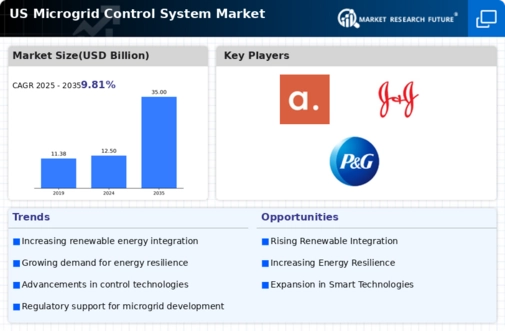Rising Energy Costs
The escalating costs of energy are driving interest in microgrid control systems as a means to enhance energy efficiency and reduce expenses. In recent years, energy prices in the U.S. have shown a steady upward trend, with electricity costs increasing by approximately 15% since 2020. This financial pressure encourages businesses and communities to explore alternative energy solutions, including microgrids. By utilizing local energy generation and storage, microgrid control systems can significantly lower reliance on traditional energy sources, thereby mitigating the impact of rising energy costs. As organizations seek to optimize their energy expenditures, the microgrid control-system market is likely to benefit from this growing focus on cost-effective energy management.
Focus on Energy Independence
The pursuit of energy independence is increasingly influencing the microgrid control-system market. As geopolitical tensions and supply chain vulnerabilities become more pronounced, the U.S. is prioritizing self-sufficiency in energy production. Microgrids offer a viable solution by enabling localized energy generation and consumption, reducing dependence on external energy sources. This trend is particularly relevant for remote communities and critical infrastructure, where energy security is paramount. In 2025, the U.S. government is expected to allocate significant resources to promote energy independence initiatives, further driving the adoption of microgrid control systems. This focus on self-reliance not only enhances national security but also supports the growth of the microgrid control-system market.
Growing Demand for Renewable Energy
The increasing emphasis on renewable energy sources is a pivotal driver for the microgrid control-system market. As the U.S. transitions towards cleaner energy, the integration of solar, wind, and other renewables into microgrids becomes essential. In 2025, renewable energy accounted for approximately 20% of the total energy generation in the U.S., and this figure is projected to rise. Microgrid control systems facilitate the efficient management of these diverse energy sources, optimizing their use and enhancing grid stability. This trend not only supports sustainability goals but also aligns with federal and state initiatives aimed at reducing carbon emissions. Consequently, the microgrid control-system market is likely to experience robust growth as utilities and private entities invest in these technologies to meet the rising demand for renewable energy solutions.
Increased Investment in Infrastructure
Investment in energy infrastructure is a significant driver for the microgrid control-system market. The U.S. government has recognized the need to modernize its energy grid, with proposed funding exceeding $100 billion for infrastructure improvements. This investment aims to enhance grid resilience and reliability, particularly in the face of climate change and extreme weather events. Microgrid control systems play a crucial role in this modernization by enabling localized energy management and reducing transmission losses. As utilities and municipalities seek to upgrade their infrastructure, the demand for advanced microgrid control systems is expected to surge. This trend indicates a shift towards more decentralized energy solutions, which could reshape the landscape of energy distribution in the U.S.
Technological Integration and Smart Grids
The integration of advanced technologies into energy systems is a key driver for the microgrid control-system market. The advent of smart grid technologies, including IoT and AI, enhances the capabilities of microgrid control systems, allowing for real-time monitoring and management of energy resources. In 2025, it is estimated that smart grid investments in the U.S. will exceed $50 billion, reflecting a strong commitment to modernizing energy infrastructure. This technological evolution enables more efficient energy distribution and consumption, which is crucial for the effective operation of microgrids. As utilities and private entities adopt these innovations, the microgrid control-system market is poised for substantial growth, driven by the demand for smarter, more responsive energy solutions.

















Leave a Comment